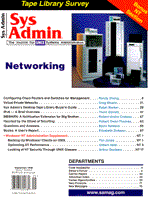
Sidebar : What is Samba?Samba is a suite of programs that work together to allow clients to access a server's filespace and printers via the SMB (Server Message Block) protocol. Initially written for UNIX, Samba now also runs on Netware, OS/2, and VMS. In practice, this means that you can redirect disks and printers to UNIX disks and printers from LAN Manager clients, Windows for Workgroups 3.11 clients, Windows NT clients, Linux clients, and OS/2 clients. There is also a generic UNIX client program supplied as part of the suite, which allows UNIX users to use an ftp-like interface to access filespace and printers on any other SMB servers. This gives the capability for these operating systems to behave much like a LAN Server or Windows NT Server machine, only with added functionality and flexibility designed to make life easier for administrators. The components of the suite are (in summary):
smbd - The SMB server. This handles actual connections from clients, doing all the file, permission and username work nmbd - The Netbios name server. This helps clients locate servers, doing the browsing work and managing domains as this capability is being built into Samba smbclient - The UNIX-hosted client program smbrun - A little "glue" program to help the server run external programs testprns - A program to test server access to printers testparms - A program to test the Samba configuration file for correctness smb.conf - The Samba configuration file smbprint - A sample script to allow a UNIX host to use smb client to print to an SMB server Documentation - DON'T neglect to read it; you will save a great deal of time!
The suite is supplied with full source (of course) and is covered by the GNU licensing scheme. (This information was taken from the Samba Web site: http://samba.anu.edu.au/samba/.)
|